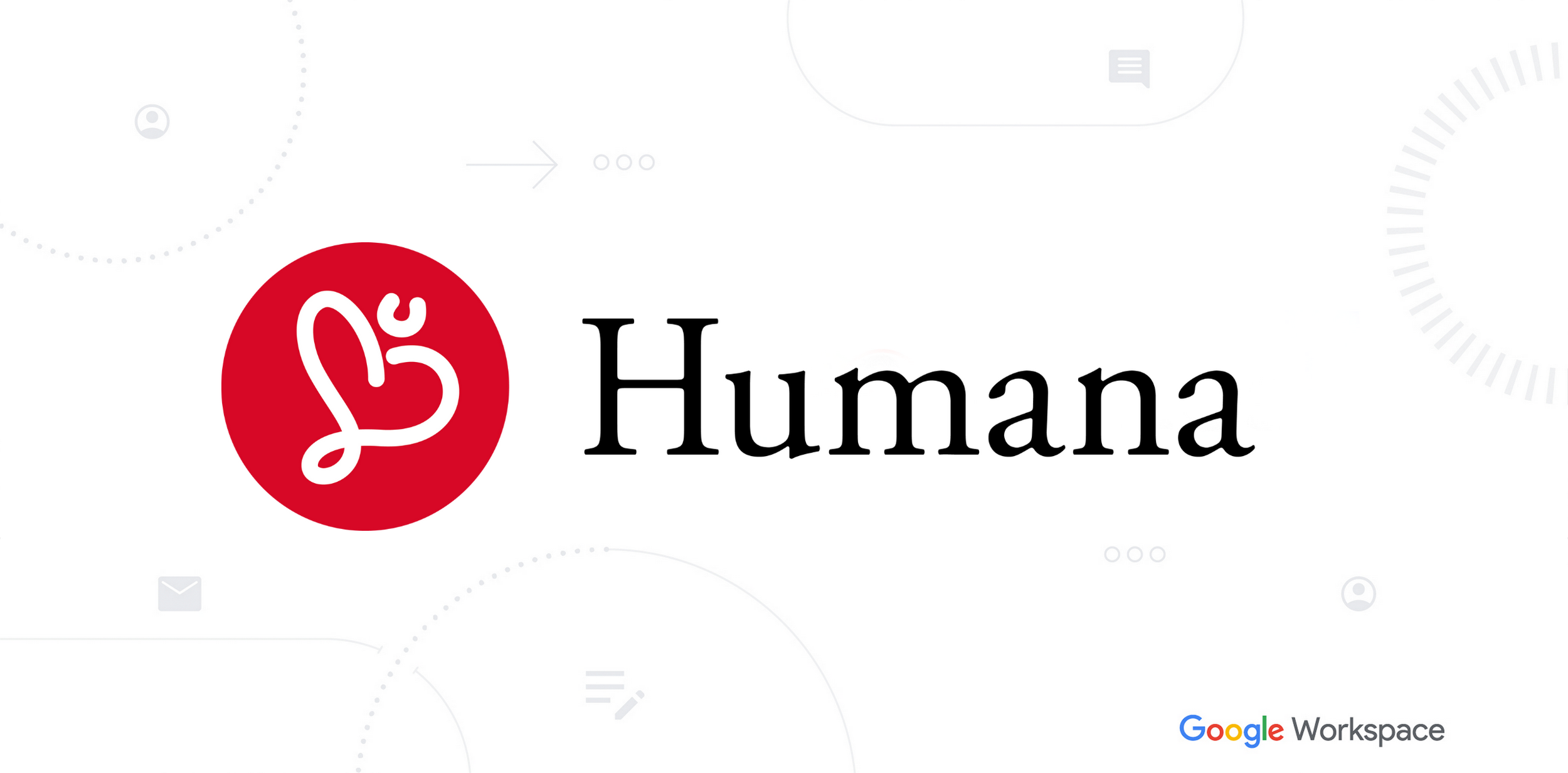Humana cuts IT costs and tightens security with 13,000-user Google Workspace migration

The Google Workspace Team
Google Workspace Newsletter
Keep up with the evolving future of work and collaboration with insights, trends, and product news.
SIGN UP

“I’m 100% confident that the Humana team is happier and more productive with Google Workspace than they were with our previous platform, and together with ChromeOS it will make our data more secure than ever before.”
—Adam Nerell, CIO, Humana
The easy-to-use collaboration tools in Google Workspace have improved morale and efficiency among 13,000 field and in-office team members, and the IT team is now confident that time-tested Workspace security features are keeping sensitive customer data safe. Additionally, Humana expects the migration to Workspace to reduce tech support requests by at least 50%.
Snapshot:
13,000 Humana team members migrated to Workspace in just four months
22TB of data migrated, including 55 million emails, 5.5 million documents, and 4.5 million calendar items
Built-in security features and browser-based apps save IT time and costs
Steady reduction in help desk tickets during and after rollout
The mission and the challenge
At Humana, taking care of business means taking care of people — and that’s not done sitting behind a desk.
“Most of our team are care workers out in the field, in customers’ homes or in designated care facilities” explains Adam Nerell, the CIO of Humana, which is a leader in care provision services for families, the elderly, and the disabled in Sweden, Finland, and Norway. “Their focus is people, not computers, and they need easy-to-use software that lets them concentrate on caring for their clients.”
But instead of intuitive tools, the Humana team was bogged down by a suite of desktop-based office applications overstuffed with unused features. Worse still, 70% of IT’s time was spent maintaining and securing these memory-intensive applications on laptops and desktop computers.
The Humana team could collaborate on documents, spreadsheets, and presentations — but not easily. “Working on the same documents offline and online led to syncing errors and version control nightmares,” Nerell recalls.
Without a centralized file system, documents sent over email often got lost. And the inconsistencies between the browser- and desktop-based versions of the software led to frustration and complaints to IT. “We were always fighting our way through a blizzard of help desk tickets,” Nerell recounts, “so we decided to look for a simpler, cloud-based solution.”
Many at Humana already had personal experience with Workspace apps like Gmail, Google Drive, Meet, and Docs. “When we announced we’d be transitioning to Google, there was naturally some anxiety among new users, but also excitement from those familiar with software,” recalls Jonatan Arenius, Humana’s communications chief, who oversaw change management for the project.


Humana’s care workers in the field need easy-to-use collaboration tools to focus on their clients rather than technology
The switch to Google Workspace
Humana’s IT team rolled out Workspace to 13,000 Humana field- and office-based employees, migrating 22TB of data along the way, in just four months. “Things got better immediately,” according to Arenius. “While it was an adjustment for those unfamiliar with working in an entirely browser-based system, new users got the hang of it quickly.”
Because Workspace users share links to files rather than the files themselves, documents are centralized on Google Drive, making them easy to find. People can also now collaborate on documents simultaneously, eliminating version control issues.
After the training that preceded the go-live date, Humana set up country-specific Google Chats where team members new to Workspace could ask their more seasoned peers — unofficially dubbed “Google Guides” — for help when they hit stumbling blocks. The average wait time for a response? “Fifteen minutes,” reports Arenius proudly, “and often even sooner.”
That kind of team enthusiasm kept users productive and contributed to the overall success of the rollout. “Google Workspace worked well from the start, and when our team found that it delivered as we’d promised, they were very pleased,” Arenius continues.
Streamlined IT and vastly improved security
The IT-team was won over by how quickly they were up and running with a better set of tools, which boosted morale. Nerell himself was impressed by how simple Workspace is to support and maintain Humana’s new platform. He reports that the entire migration was done with no increase in help desk tickets; in fact, there has been a steady decline in tickets since Workspace was implemented. “Plus, going forward we no longer have to maintain applications downloaded on client computers—all we do is install the Chrome web browser, and people can begin using all Workspace apps.”
Nerell also underscores Google’s long record of investment in security features that are built into the platform and included with the subscription price. “I no longer lose sleep over computer vulnerabilities and exposures and other security concerns,” he says. “Before, I always felt exposed.”
For example, the AI-powered defenses in Gmail automatically block more than 99.9% of spam, phishing attempts, and malware, and the Workspace cloud-only architecture doesn’t require patching or securing desktop client apps or backend servers. “Our business process and network management costs are decreasing as well,” he notes.
Buoyed by the success of the rollout, Humana decided to combine the project with the replacement of their CMS and intranet platform, another high-profile endeavor. “We demonstrated we could handle large-scale projects efficiently, and that translated to our colleagues’ openness to new ways of doing things,” he adds.
For example, in addition to Google Docs, Sheets, Slides, Calendar, and Chat, Humana team members have begun working with Google Sites to build small intranets for Workspace training materials and Humana conference information, and Google Forms for internal surveys about the technology as well as conference registrations.


The Humana team uses Google Sites to build websites with upcoming conference info and Google Forms to distribute post-conference surveys to attendees
Looking ahead
As Humana is moving towards a steady state with Workspace, Nerell and Arenius are putting best practices in place as part of their overall change management plan. “The way we’ve always done things is not necessarily the best way,” Arenius admits, “and now we have the tools to help people collaborate more efficiently.” New best practices will be included in training for new team members.
Next up for IT: moving to ChromeOS. “Among the many reasons we’ve decided to migrate from Windows is how seamlessly ChromeOS works with Google Workspace,” Nerell says, noting that Workspace documents will automatically be saved to Drive, making it even easier for the Humana team to locate, share, and collaborate documents. “Plus ChromeOS has had zero reported ransomware attacks,” he notes, adding, “We have very high trust in the security Google provides.”
Once ChromeOS is in place, Nerell predicts the already diminishing number of help desk tickets will decrease by half over the following year — and that he’ll realize cost reductions that go along with such a dramatic decrease.
“I’m 100% confident that the Humana team is happier and more productive with Google Workspace than they were with our previous platform, and together with ChromeOS it will make our data more secure than ever before,” Nerell concludes.



